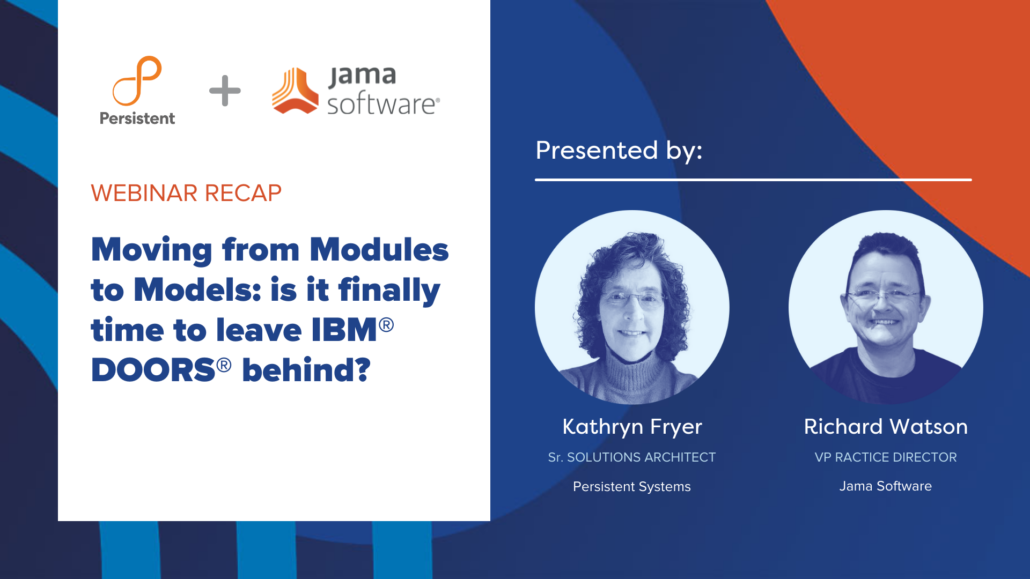
In this blog, we recap the “Moving from Modules to Models – Is it finally time to leave IBM® DOORS® behind?” webinar.
As products grow increasingly complex, many teams are asking themselves if they have become complacent in how we approach requirements management and the value it delivers.
Regardless of the industry, requirements are critical to a shared understanding of the solution. They provide the foundation for traceability and regulatory compliance across the product or software’s lifecycle. Many companies are finding that using IBM® DOORS® for requirements management limits their ability to lay that common foundation.
In this webinar, experts from Persistent Systems and Jama Software® will discuss issues and challenges around the continued use of IBM® DOORS® and show how adopting a model-based requirements approach enables best practices to realize greater value from your engineering initiatives.
In this session, we will cover:
- An overview of why requirements management is critical
- Common challenges and pitfalls companies face
- Best practices enabled by a model-based engineering approach
- The path to successful adoption, reducing migration uncertainty and risk
- How to start your migration journey
Below is an abbreviated transcript and a recording of our webinar.
Moving from Modules to Models – Is it finally time to leave IBM® DOORS® behind?
Richard Watson: Hi folks, my name is Richard Watson. I work with Jama Software. I’m a practice director with Jama. My history is around systems engineering. I’ve been a systems engineer, I guess, for about 30 odd years, mostly with DOORS and DOORS Next. So my previous role was the product manager of DOORS before I moved into Jama Software. I’m thrilled today to be joined by Kathryn Fryer. Kathryn works for Persistent Systems and she too has got about 30 years of systems engineering experience. And she and I worked for a long time together inside of IBM, working on both DOORS and DOORS Next Generation. We’re here today to talk about data model consistency, and perhaps migrating your data to a consistent data model. So we’re going to start with Kathryn. So Kathryn, over to you.
Related: Jama Connect® Solution for IBM® DOORS®
Kathryn Fryer: Okay. Thanks, Richard. So I just wanted to start, for those of you who might not be familiar with Persistent Systems, we are a global company, been around for actually about 30 years, over 700 million in revenue and that was a huge increase year over year. And if you move to the next slide, we cover many different industries and solutions, and we partner with many different companies, everyone from Salesforce to Microsoft, to IBM and Jama.
So with that brief introduction, let’s move on to the topic at hand and talk about requirements management and model-based engineering. So these quotes might be familiar to you, certainly, the sentiment that they convey is familiar, requirements management is key to the success of software and systems projects, and poor requirements management is the single largest reason for project failure. And the costs of failure can be billions of dollars or pounds or euros, the cost of product recalls, of missing regulatory compliance, and never mind as we get into some of these industries, the cost affecting human life. So I know you’re all familiar with that and you know how important requirements management is, or you wouldn’t be here today. So if we move to the next slide, Richard?
Related: The Comprehensive Guide to Successfully Adopting Model-Based Systems Engineering (MBSE)
Kathryn Fryer: So what makes it hard? Why are we still talking about it? And there’s four CS here, I think I refer to them in the past as well. And I don’t think these are new, this list is familiar. This has been true for a number of years now, and it continues to be true. Solutions become increasingly complex. We have more components, more moving pieces, more integrations, more dependencies. We have more contributors involved in delivering the solutions. So we need to collaborate, not even just within your organization, across the teams in your organization, but across different suppliers and then their suppliers. We have these diverse engineering teams, diverse tools, diverse processes, and we need that collaboration, the handshakes, the clear handoffs, and the understanding of the context, there’s another C I didn’t put on the slide, and how all the things must work together.
We need to manage change. Change is the only constant, right? So we need to stay on top, not just of changes in our project, but also changes in technologies and changes in standards and compliance. Compliance seems to be growing and evolving all the time. The specifics are going to vary by your industry and by your geography, but compliance is necessary in almost every industry now, I think, and that’s only going to grow with things like AI and autonomous capabilities and all that fun stuff. So there’s lots of things that we need to deal with.
Watch the full webinar to learn more: Moving from Modules to Models – Is it finally time to leave IBM® DOORS® behind?
RELATED
- Navigating AI Safety with ISO 8800 in Road Vehicles - August 7, 2025
- Automotive Industry Signs Memorandum of Understanding - July 15, 2025
- Construction’s Next Leap: AI as a Strategic Partner - June 26, 2025